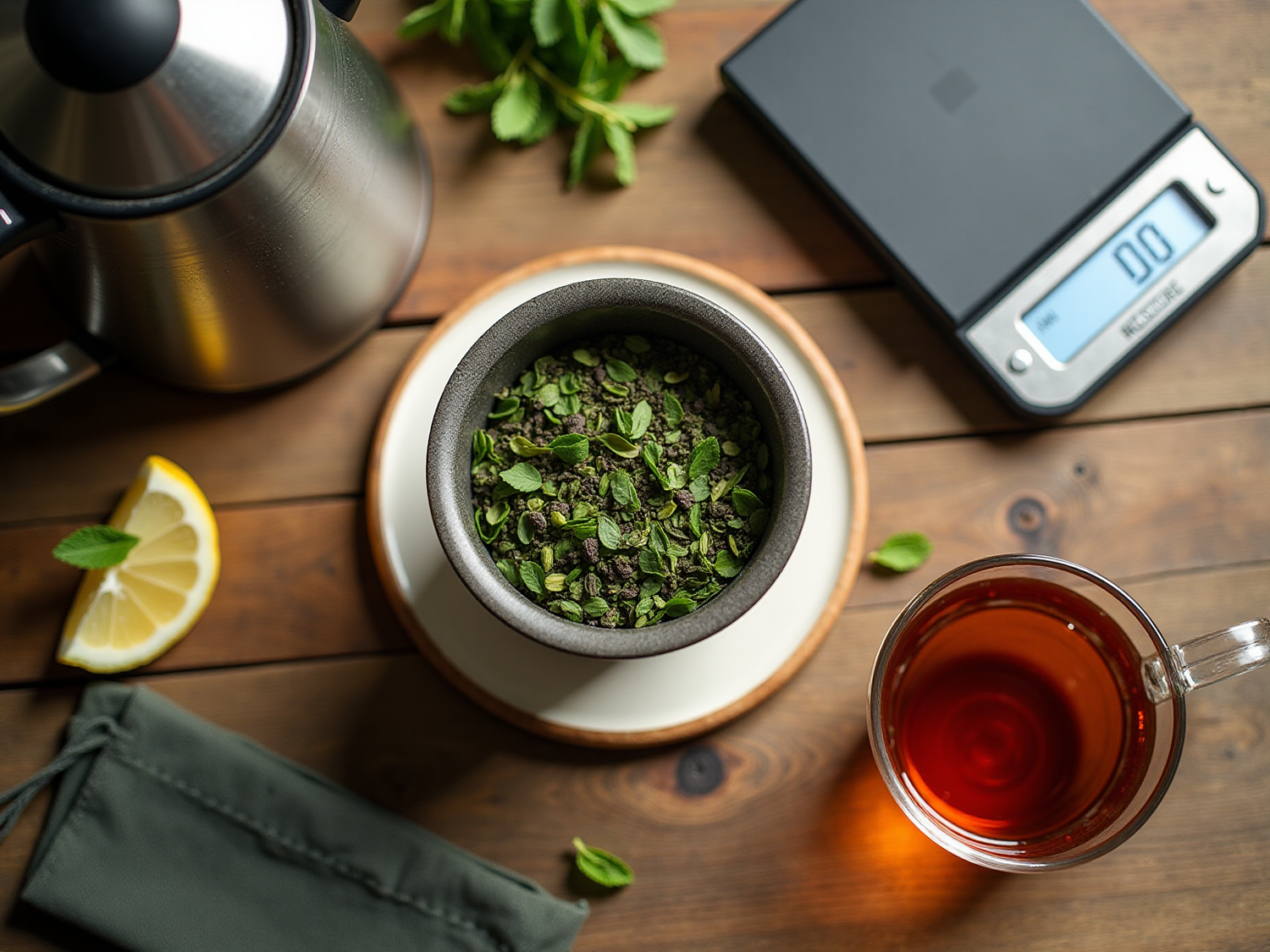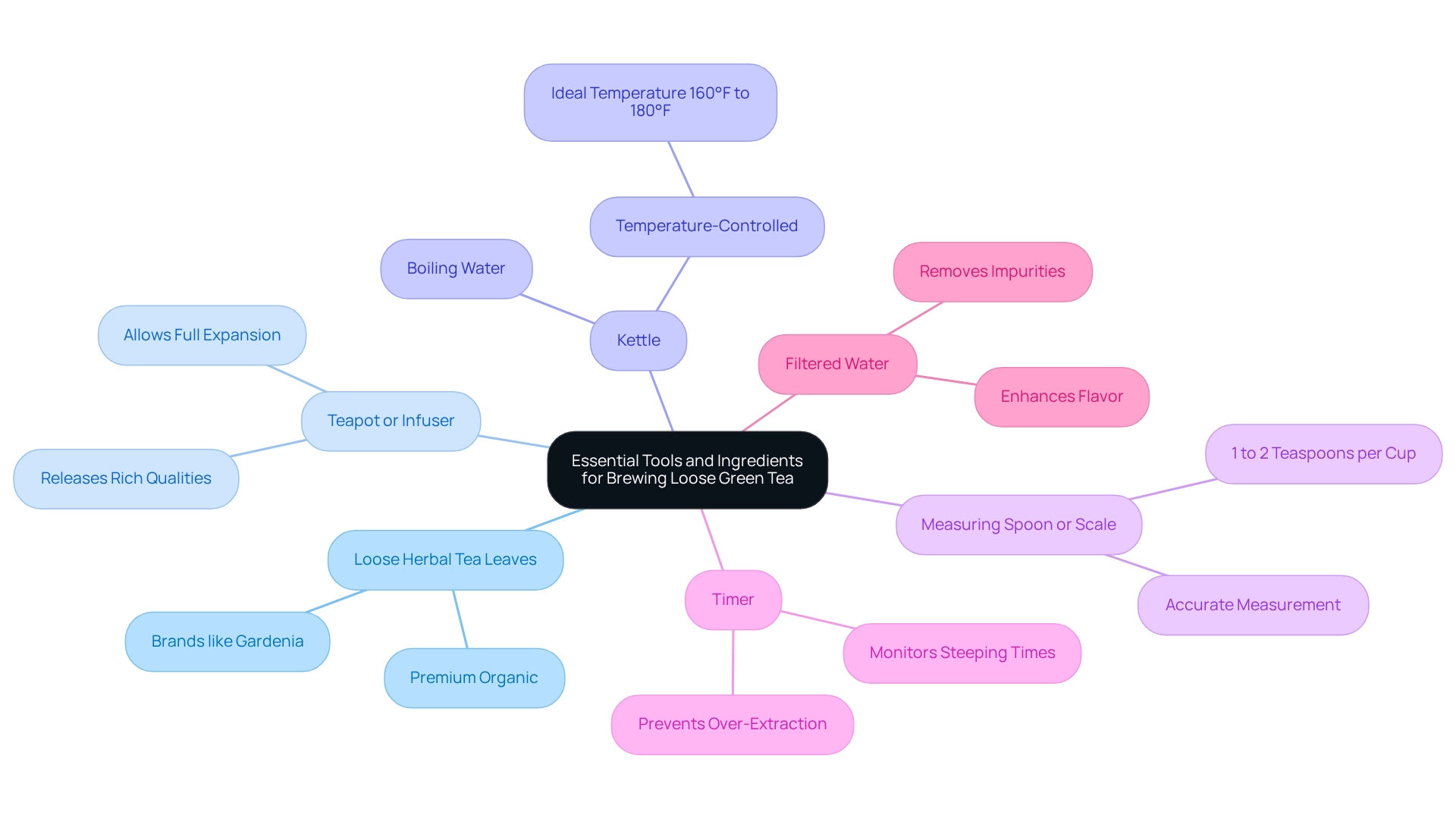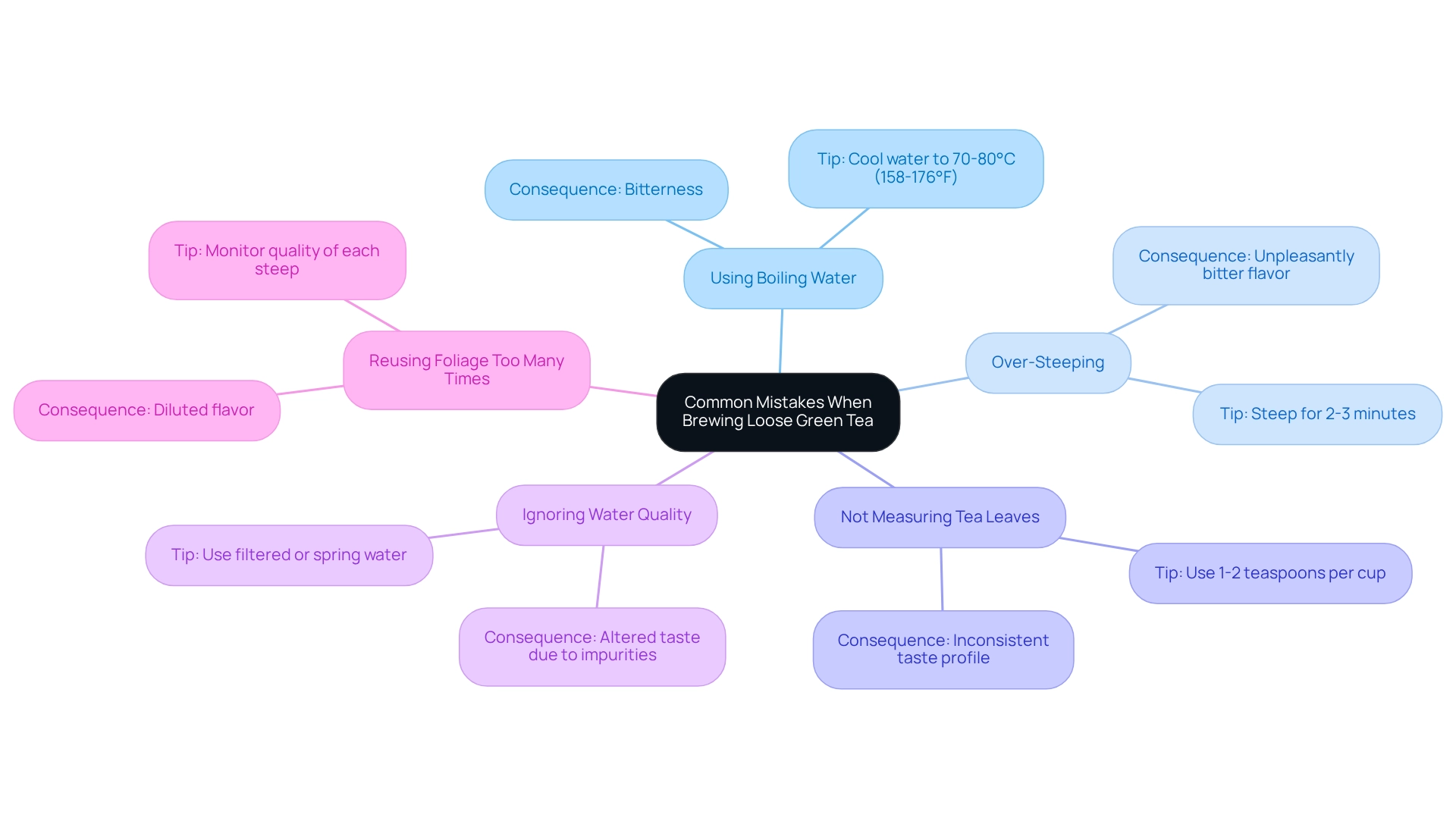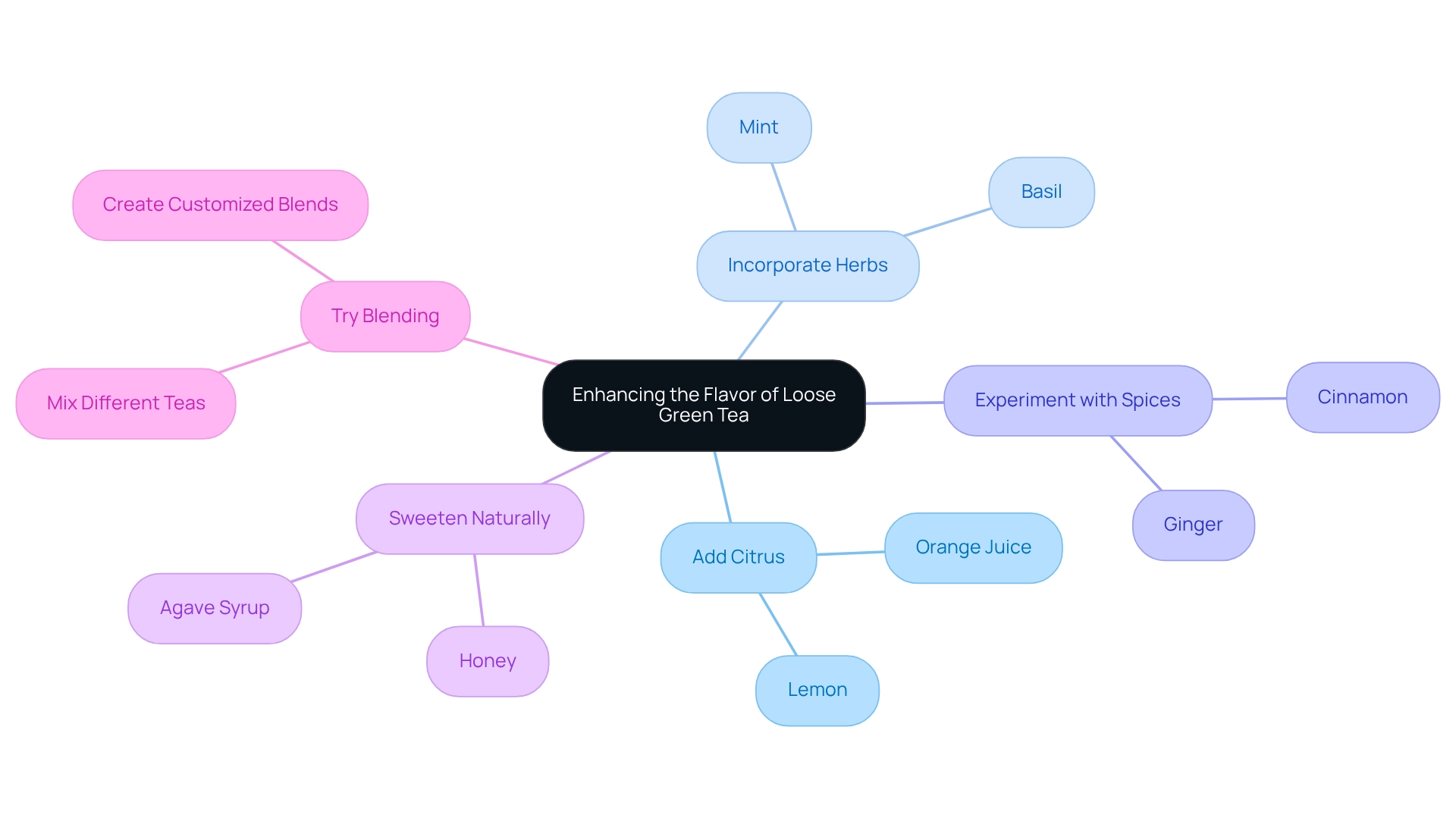How to Brew Loose Green Tea Leaves: A Step-by-Step Guide

Overview
Brewing loose green tea leaves is a delightful journey that requires a thoughtful approach. By selecting quality leaves and using the right tools, you can create an experience that goes beyond just drinking tea. It's essential to pay attention to the optimal temperature and steeping time, as these factors significantly enhance the flavor and health benefits of your brew.
Imagine savoring a cup of tea that not only tastes exquisite but also supports your well-being. Research shows that the brewing conditions can impact the tea's antioxidant properties, enriching your overall experience. As you explore the world of green tea, consider how these simple steps can transform your daily ritual into a moment of mindfulness and care.
So, why not take a moment to reflect on your tea-brewing practices? Embrace the opportunity to elevate your tea experience, and discover the joy that comes from nurturing your body and spirit with every sip.
Introduction
Brewing loose green tea is not just a routine; it’s an art that intertwines precision, quality ingredients, and a personal touch to create a truly delightful experience. With the right tools and techniques, along with a bit of knowledge, anyone can elevate their tea game. Imagine selecting high-quality loose leaves, mastering the perfect water temperature, and timing your steeping just right—each of these elements plays a vital role in unlocking the rich flavors and health benefits of this beloved beverage.
As more individuals embrace green tea for its wellness properties, understanding the nuances of brewing can transform a simple cup into a moment of pure enjoyment. Have you ever considered how a well-brewed cup of tea can nourish not just your body but also your spirit? Dive into the world of loose green tea and discover how to brew the perfect cup that tantalizes your taste buds and supports your well-being. Let’s embark on this journey together and explore the joys of brewing a cup that truly resonates with you.
Essential Tools and Ingredients for Brewing Loose Green Tea
Brewing loose herbal tea effectively requires the right tools and ingredients to enhance your experience. Here’s what you need:
-
Loose Herbal Tea Leaves: Opt for premium organic loose herbal tea to enrich both taste and health benefits. Brands like Gardenika offer a diverse selection that caters to various preferences, ensuring that each cup reflects the highest standards of purity and sustainability.
-
Teapot or Infuser: A teapot equipped with an infuser or a dedicated tea infuser is essential. This allows the leaves to expand fully, releasing their rich qualities and advantageous attributes.
-
Kettle: A kettle for boiling water is indispensable. For precision brewing, consider a temperature-controlled kettle, which helps achieve the ideal water temperature for tea, typically between 160°F to 180°F (70°C to 80°C).
-
Measuring Spoon or Scale: Accurate measurement of tea leaves is crucial for achieving the desired strength and taste. A scale can ensure consistency, as the optimal amount is generally about 1 to 2 teaspoons per cup.
-
Timer: A timer is vital for monitoring steeping times, preventing over-extraction that can lead to bitterness. The suggested steeping duration for tea is typically between 3 to 5 minutes.
-
Filtered Water: The quality of water significantly impacts the taste of your tea. Using filtered or spring water can enhance the flavor by removing impurities that may alter the tea's profile.
Integrating these tools into your brewing routine not only simplifies the process but also enriches your overall tea experience. The antioxidant capacity of high-quality organic loose tea is impressive, with first brews showing notable values, specifically a CV of 30% for ORAC and 15% for NanoCerac, underscoring the health benefits linked to these premium products. Furthermore, Gardenia's commitment to quality and sustainability, evidenced by its USDA Organic and KSA Kosher certifications, along with third-party lab testing, ensures that each cup of tea supports your wellness while positively impacting the environment.
By choosing the right equipment and ingredients, you can fully savor the rich flavors and health benefits that loose green tea leaves offer. To preserve the quality of your loose tea, store it in an opaque, airtight container in a cool, dark place, and aim to use it within a year of purchase.
Ready to elevate your tea experience? Shop now at Gardenia for high-quality organic loose blends and discover the wellness benefits they provide!

Understanding Water Temperature for Optimal Brewing
To brew loose green tea leaves perfectly, the ideal water temperature typically falls between 160°F and 180°F (70°C to 82°C). Reaching this exact temperature is essential for revealing the tea's complete flavor and health advantages, especially those provided by Gardenika's organic loose green tea leaves, made with traditional herbs to enhance wellness and balance. Here’s a simple step-by-step guide to help you achieve the optimal brewing conditions:
- Boil Water: Start by bringing your water to a rolling boil.
- Cool Down: After boiling, remove the kettle from the heat and allow it to cool for approximately 2-3 minutes. This cooling period is crucial, as it helps the water drop to the ideal range for herbal tea.
Use a Thermometer: For precision, use a thermometer to verify the water temperature before pouring it over the tea leaves.
Brewing loose green tea leaves at the correct temperature is vital; if the water is too hot, it can scorch the leaves, resulting in a bitter flavor and reduced health benefits. Research, including the study titled 'Impact of Brewing Conditions on Tea,' shows that the antioxidant activity and chemical profiles of tea are significantly influenced by brewing conditions, particularly temperature. For example, at 95 °C, the total catechin levels peak after just 10 minutes, while at 60 °C, the concentrations of epi-structured catechins peak between 30-60 minutes before slightly decreasing.
This underscores the importance of careful temperature management. Moreover, our commitment to excellence shines through in its USDA Organic and Kosher certified products, including loose green tea leaves, which have received over 2000 five-star ratings, reflecting customer satisfaction with the quality of its offerings. By following these steps, you can ensure that each cup of Gardenika's herbal tea not only tastes delightful but also maximizes its wellness properties.
Shop now to explore our selection of organic loose green tea leaves. Discover how our unique blends, infused with herbs like chamomile for relaxation and echinacea for immune support, can enhance your well-being.

Measuring Loose Green Tea Leaves: Tips and Guidelines
To measure loose herbal tea accurately and achieve the best taste, consider these gentle guidelines:
-
A standard recommendation is to use approximately 1 teaspoon (about 2 grams) of loose green tea leaves for every 6-8 ounces of water. Feel free to adjust this according to your personal taste preferences, allowing for a customized brewing experience that suits your unique palate.
-
Use a Scale: For optimal precision, employing a digital scale is highly advisable. This tool can be a wonderful companion for those wishing to experiment with varying strengths and flavors, ensuring consistency in each brew. As highlighted in a study, the proposed sparse-model-based technique revealed excellent capability in the discrimination of grades of tea quality, underscoring the importance of accurate measurements in your tea journey.
-
Consider Tea Size: The dimensions of the tea components play a crucial role in measurement. Bigger foliage may need a larger volume to attain the same strength as smaller ones. Understanding this can greatly influence your brewing process and the resulting taste profile. The effect of harvesting criteria on tea quality highlights that appropriate plucking methods, like choosing two leaves and a bud, can enhance the overall quality of your tea.
Precise measurement is essential for brewing with loose green tea leaves, as it directly affects the taste and strength of your tea. Studies indicate that the entire process from enzyme deactivation to data acquisition for quality assessment takes about 18-20 minutes, emphasizing the value of precision in tea preparation. By following these guidelines, you can enrich your tea-drinking experience, ensuring a balanced and flavorful brew every time.
Additionally, advancements in integrated systems aim to improve efficiency in quality inspections at tea factories, reflecting industry standards that prioritize quality and consistency. So, why not take a moment to explore the world of loose leaf teas and discover the delightful flavors that await you?

Steeping Time: How Long Should You Brew Loose Green Tea?
The perfect steeping duration for loose green tea typically ranges from 2 to 3 minutes, allowing for optimal extraction without bitterness. Let's explore a step-by-step approach to perfecting your brew:
- Start with 2 Minutes: Begin by steeping your tea for 2 minutes. This initial duration gently extracts the essences, ensuring a smooth taste that you’ll appreciate.
- Taste Test: After the first 2 minutes, take a moment to sample the tea. If you desire a more robust flavor, consider extending the steeping time by an additional 30 seconds to 1 minute, tasting periodically to discover your preferred strength.
- Adjust for Preferences: Keep in mind that various types of tea may require slight modifications in steeping duration. For instance, Japanese teas, like Sencha, typically thrive with shorter steeping times, while Chinese varieties may benefit from a slightly longer infusion.
Research indicates that steeping duration significantly impacts the flavor profile and health benefits of tea. A study titled "Influence of Steep Time on Tea Properties" revealed that most beneficial compounds, including polyphenols, are released within the first 5 minutes of steeping. This highlights the importance of timing in maximizing both taste and health benefits.
Moreover, Shanika Dasanayaka observes that "tea drinkers have a lower risk of dying from any cause," further underscoring the health benefits of proper steeping.
If you're curious about other tea types, consider that Pu-erh tea should be infused for four to five minutes, while Oolong rolled tea is best steeped at a temperature of 185-205°F for 3-5 minutes. Additionally, hibiscus tea should be steeped for 5 or more minutes, illustrating the variability in steeping recommendations across different tea types.
By modifying your steeping duration based on these guidelines, you can create a cup of tea that perfectly matches your taste preferences, enhancing your overall tea-drinking experience. Embrace the journey of discovering your ideal brew, and enjoy the warmth and comfort that a well-steeped cup of tea can bring.

Different Brewing Methods for Loose Green Tea: A Comparative Guide
Brewing loose green tea leaves can truly be an art form, offering a variety of methods that provide unique tastes and experiences. Let’s explore some popular techniques that can enhance your tea journey.
-
Western Style: This straightforward approach involves using a teapot or infuser. Simply add the desired amount of tea to the infuser, pour hot water over it, and steep for the recommended duration. This method is especially easy for novices, ensuring a uniform taste profile that is comforting and familiar.
-
Gong Fu Style: A traditional Chinese brewing method, Gong Fu utilizes a small teapot or gaiwan. This method consists of several brief steps, usually lasting 15 to 30 seconds each, which aids in extracting a variety of taste profiles from the same materials. It’s celebrated for its ability to highlight the tea's complexity and nuances, inviting you to savor each moment.
-
Cold Brew: For a refreshing alternative, cold brewing entails soaking tea components in cold water for a prolonged duration, typically between 6 to 12 hours. This method results in a smooth, less bitter flavor, making it an excellent choice for warm weather or those sensitive to caffeine, creating a delightful experience.
-
French Press: Using a French press for tea is another effective method. Simply add the loose bits, pour hot water, and after the steeping time, press down the plunger to separate the solids from the liquid. This technique allows for easy removal of leaves and can produce a robust flavor that many find satisfying.
Research indicates that the brewing temperature and time significantly affect the extraction of beneficial compounds. For instance, brewing herbal tea at 85 °C for 3 to 5 minutes has been shown to yield optimal sensory scores for color, taste, and aroma, as demonstrated in sensory evaluation studies. Longer steeping times can lead to bitterness and a loss of the tea's characteristic aroma, which can be disappointing.
Additionally, studies reveal that higher yields of vitamin C, vitamin B2, epicatechin, and epigallocatechin are obtained from lower temperature brewing methods. This emphasizes the health benefits of proper brewing techniques, encouraging you to take care of your wellness. Moreover, the antioxidant characteristics of this tea are more closely associated with polyphenolic compounds than with other antioxidants, highlighting the significance of brewing techniques in optimizing health advantages.
By trying out these techniques, you can discover your preferred way to enjoy loose green tea leaves, enhancing both the taste and health benefits of this remarkable beverage. We extend our heartfelt gratitude to the CAYKUR Tea Factory for providing the tea utilized in this study, as we embark on this delightful journey together.

Health Benefits of Loose Green Tea: Why You Should Brew It
Brewing and enjoying loose green tea from Gardenika can truly enrich your well-being, offering a variety of health benefits that resonate with your wellness journey. Here are some remarkable advantages:
-
Rich in Antioxidants: our organic loose leaf tea is filled with polyphenols, especially catechins, which are potent antioxidants. These compounds help combat oxidative stress, reduce inflammation, and may lower the risk of chronic diseases, allowing you to feel your best.
-
Supports Weight Management: The catechins in our herbal tea are known to boost metabolism and encourage fat oxidation. By incorporating loose green tea leaves into your weight management plan, you can enhance your efforts and work towards your health goals more effectively.
-
Enhances Brain Function: The unique combination of caffeine and L-theanine in Gardenika's herbal tea has been shown to improve brain function. This blend enhances focus, alertness, and cognitive performance, making it an excellent choice for anyone seeking mental clarity and productivity.
-
Promotes Heart Health: Studies indicate that regularly enjoying Gardenika's herbal tea is associated with lower cholesterol levels and improved cardiovascular health. This protective effect can contribute to a longer, healthier life, giving you peace of mind.
-
Aids Digestion: The anti-inflammatory properties of our herbal tea can promote digestive wellness, easing discomfort and fostering a balanced gut environment, which is essential for overall health.
Incorporating organic loose green tea leaves into your daily routine not only supports your overall wellness but also aligns with a lifestyle centered on health and vitality. With its proven benefits—including a potential reduction in the risk of pancreatic cancer, especially in women, and its role in managing conditions like type 2 diabetes—this tea stands out as a powerful ally in your health journey. Additionally, Gardenika's commitment to sustainability and eco-friendly practices ensures that every cup of tea you enjoy is beneficial for both you and the planet.
As Wei Zheng aptly noted, "The antioxidant qualities of herbal tea are crucial for enhancing health and avoiding illness," highlighting the importance of integrating this delightful drink into your diet. Explore the advantages of Gardenika's organic loose herbal tea today and discover a sense of equilibrium with our traditional herbs.

Common Mistakes to Avoid When Brewing Loose Green Tea
Brewing the perfect cup of loose green tea can be a delightful journey, but it’s important to steer clear of these common pitfalls:
-
Using Boiling Water: Scorching the delicate leaves with boiling water can lead to bitterness. Instead, take a moment to let the water cool to the ideal temperature, around 70-80°C (158-176°F). Studies show that caffeine concentrations in herbal tea remain consistent at these temperatures, allowing for a balanced and enjoyable taste.
-
Over-Steeping: Leaving the tea leaves in water for too long can create an unpleasantly bitter flavor. To savor the finest taste, follow the suggested steeping times—usually just 3-5 minutes for green tea.
-
Not Measuring Tea Leaves: Inconsistent measurements can greatly affect the taste profile of your brew. To ensure a balanced cup, always measure your tea, typically using about 1-2 teaspoons per cup.
-
Ignoring Water Quality: The quality of the water you use can significantly impact the flavor of your tea. Tap water may contain impurities that alter the taste, so opt for filtered or spring water for the best results.
-
Reusing Foliage Too Many Times: While some high-quality leaves can be steeped multiple times, excessive reuse may lead to a diluted flavor. Keep an eye on the quality of each steep to maintain a satisfying taste.
As Kei Nishida, CEO of Japanese Tea Co., wisely notes, 'Bright vibrant or very vibrant leaves do not indicate fresh tea.' This highlights the importance of using fresh ingredients for the best results.
By avoiding these common mistakes, you can enhance your brewing technique and enjoy a more flavorful cup of tea, enriching your overall tea-drinking experience. Furthermore, Gardenika's commitment to organic sourcing and eco-friendly practices ensures that the tea you brew not only tastes wonderful but also supports your health and the environment.

Enhancing the Flavor of Your Loose Green Tea: Tips and Tricks
To elevate the flavor profile of your loose green tea, consider implementing the following nurturing strategies:
- Add Citrus: Incorporating a slice of lemon or a splash of orange juice can invigorate the taste, introducing a refreshing zest that beautifully complements the tea's natural notes.
- Incorporate Herbs: Fresh herbs such as mint or basil not only enhance the aroma but also contribute a unique aspect to the tea, harmonizing beautifully with its inherent qualities.
- Experiment with Spices: A dash of ginger or a sprinkle of cinnamon can infuse warmth and complexity into your brew, transforming a simple cup into a comforting experience.
- Sweeten Naturally: For those who enjoy a sweeter taste, opting for honey or agave syrup instead of refined sugar can provide a more wholesome sweetness that pairs wonderfully with the tea's profile.
- Try Blending: Mixing various types of loose leaf teas enables you to create customized blends, merging tastes and health advantages suited to your preferences.
Research indicates that these enhancements not only improve the sensory experience but also align with consumer preferences for flavoring tea. Many tea lovers report that incorporating citrus and herbs can greatly enhance the overall taste, turning each cup into a delightful journey of sensations. Moreover, studies on the impact of storage on tea quality reveal that preserving the integrity of taste compounds is essential, as certain pigments and antioxidative properties can weaken over time.
For instance, the overall amino acid content demonstrates a highly significant negative correlation with storage years (r = -0.9883, < 0.001), highlighting the importance of proper storage in maintaining taste quality. Additionally, a case study discovered that chlorophyll-b and carotenoids significantly decline with storage duration, which can impact the quality and antioxidative properties of tea. As Koushik Adhikari noted, "The Authors also are grateful to Koushik Adhikari for information on the GC-MS data," underscoring the scientific backing behind these flavor enhancement techniques.
By applying these gentle tips, you can ensure that your tea-drinking ritual becomes a flavorful journey, keeping your loose green tea vibrant and enjoyable.

Conclusion
Brewing loose green tea is not just a process; it’s a delightful journey filled with numerous health benefits. By choosing high-quality ingredients and essential tools—like a suitable teapot, accurate measuring devices, and a temperature-controlled kettle—you can truly enhance your tea preparation. Understanding the significance of water temperature, steeping time, and precise measurements ensures that each cup delivers optimal flavor while maximizing the beverage's health-promoting properties.
Moreover, exploring various brewing methods, from Western style to Gong Fu and cold brew, allows you to discover your preferred approach while appreciating the unique characteristics of different green teas. By avoiding common pitfalls, such as using boiling water or over-steeping, you can refine your brewing technique, resulting in a more enjoyable and flavorful cup.
Ultimately, incorporating loose green tea into your daily routine not only supports your well-being through its rich antioxidant content and health benefits but also aligns with sustainable practices. By embracing the art of brewing green tea, you can transform a simple cup into a nourishing experience that delights your senses and contributes positively to your overall health. As you embark on this journey into the world of loose green tea, each sip becomes a moment of mindfulness, connection, and joy.
Frequently Asked Questions
What type of tea leaves should I use for brewing herbal tea?
It is recommended to use premium organic loose herbal tea leaves to enhance both taste and health benefits. Brands like Gardenia offer a diverse selection that ensures high standards of purity and sustainability.
What equipment do I need to brew loose herbal tea effectively?
You will need a teapot or infuser, a kettle for boiling water, a measuring spoon or scale, a timer, and filtered water. These tools help in achieving the best flavor and health benefits from the tea.
Why is a temperature-controlled kettle important for brewing tea?
A temperature-controlled kettle helps achieve the ideal water temperature for brewing tea, which is typically between 160°F to 180°F (70°C to 80°C). This precision is essential for revealing the tea's full flavor and health advantages.
How much loose herbal tea should I use per cup?
The optimal amount of loose herbal tea is generally about 1 to 2 teaspoons per cup. Accurate measurement is crucial for achieving the desired strength and taste.
How long should I steep loose herbal tea?
The suggested steeping duration for loose herbal tea is typically between 2 to 3 minutes. Using a timer is important to prevent over-extraction, which can lead to bitterness.
What type of water is best for brewing tea?
Using filtered or spring water is recommended as it enhances the flavor of the tea by removing impurities that may alter its profile.
How should I store loose herbal tea to preserve its quality?
Loose herbal tea should be stored in an opaque, airtight container in a cool, dark place, and it is best to use it within a year of purchase.
What are the health benefits of high-quality organic loose tea?
High-quality organic loose tea has impressive antioxidant capacity, with significant values noted in first brews. These teas can support wellness and have health benefits linked to their premium quality.
What certifications do quality herbal teas like those from Gardenia have?
Gardenia’s herbal teas are USDA Organic and KSA Kosher certified, and they undergo third-party lab testing to ensure quality and sustainability.
How does water temperature affect the brewing of tea?
Brewing tea at the correct temperature is vital; too hot water can scorch the leaves, resulting in bitterness and reduced health benefits. Proper temperature management is essential for maximizing the tea's flavor and antioxidant properties.





